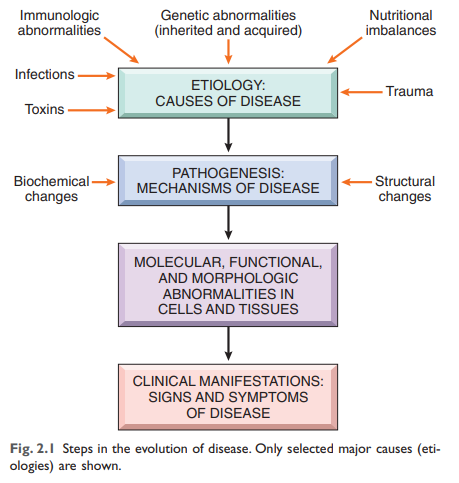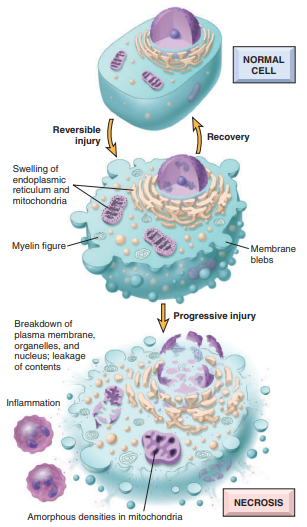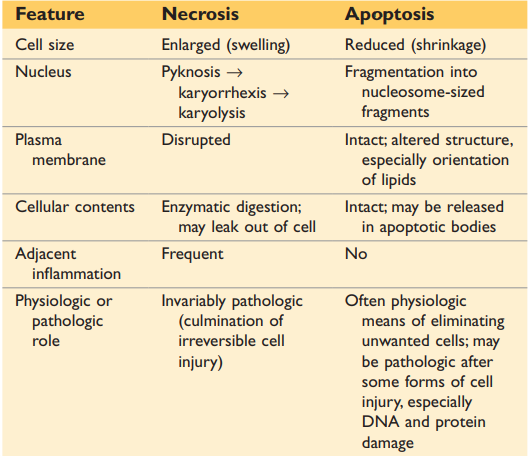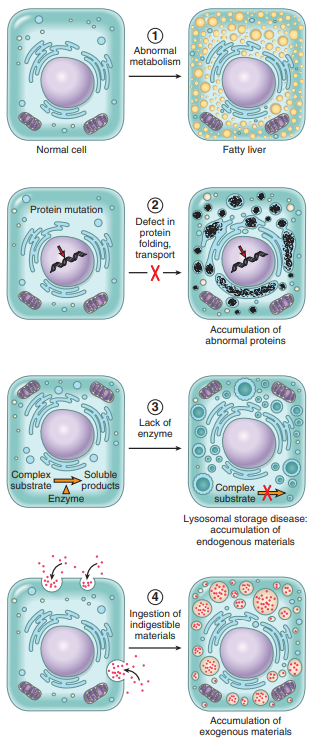R Chapter 2 - Cell injury, Adaptation and Death
<<History<<
- Hippocrates( 460-337 BC): diseases result from form disturbed balance between he found body fluids
- blood
- phlegma(thick mucus)
- black bile
- yellow bile
- Father of pathology → Rudolf Virchow
- know for the idea that diseases stem from changes in healthy cells and that each disease only affects a certain set of cells rather than the entire organism
{{Terms{{
Pathology: the study of diseases → investing the causes of diseases, the associated changes at the levels of cells, tissues
Etiology: Origin of the disease, including underlying causes and modifying factors
Pathogenesis: the mechanisms of development and progression of disease
- describes how etiological factors trigger molecular and cellular change giving rise to specific structural….

]]Causes of Cell Injury]]
- Hypoxia: oxygen deficiency
- most common cause: arterial obstruction
- Ischemia: reduced blood supply (not only liquid loss but also essential nutrients loss and build-up of waste products)
- Toxins
- air pollution
- insecticides
- CO
- Asbestos
- cigarette smoke
- ethanol
- Drugs(medical and street drugs)
- Infectious agents
- virus
- bacteria
- fungi
- protozoans
- Immunologic reactions
- autoimmune (reactions against one’s own tissues)
- allergies (reactions against environmental substances)
- inflammatory reaction
- Genetic abnormalities
- deficiency in proteins
- protein abnormalities
- triggered cell death
- Nutritional imbalance
- physical agents
- Trauma (accidents)
- extreme of temperature
- radiation
- electric shock
- changes in atmospheric pressure
- Aging
- during cells life, their ability to respond to stress decreases causing irreversible damaging → leading to death
- Stress
}}Sequence of vents in cell injury and cell death}}
}}Cellular reversible injury}}

- Reversible injury: is the state of cell injury at which the deranged function and morphology of the injured cells can return to normal if the damaging stimulus is removed
- the cell grows in size( %%cellular swelling%%) to maintain an equilibrium since energy depend on ion pumps start failing, causing a disbalance in the cytoplasm
- %%Fatty changes%% are the manifestation of lipid vacuoles
- cell becomes more “purple.”
- blebbing
- three phenomena → Point of no return to cell death
- inability to restore mitochondrial function
- loss of structure and functions of the plasma membrane and intracellular membranes
- loss of DNA and chromatin structural integrity
}}Cell Death}}
- Causes for cell death
- loss of oxygen and nutrient supply → called ischemia
- actions of toxins
}}Necrosis}}
- Necrosis: uncontrollable form of death
- resulted from severe damage and caused the membrane to burst, and intracellular enzymes treat leaking out, causing the cell to digest itself
- does not occur in healthy tissue; only occurs in pathologic processes
- Types of tissue necrosis
- Coagulative necrosis → blockage of blood -→ tissue dies
- Liquefactive necrosis → necros in the brain often causes liquefactive
- gangrenous necrosis → infection of bacterium that causes fast necrosis + swelling of legs + low temperature
- Caseous necrosis → when a secluded area, that experiences necrosis the macrophages are locked in causing the tissue to look like cjees
- Fat necrosis → when fat suddenly dies because when you have pancreatitis the enzyme that break down fat, start digestion fat storages → causing fat break down all over your bod<
- Fibrinoid necrosis
}}Apoptosis}}
Apoptosis: controlled cell death
clears cell fragments in vesicles to prevent inflammatory reactions that could damage neighboring cells triggered by the enzymes called %%caspases%%
causes of apoptosis
Physiological triggers that happen in healthy bodies
- loss of growth factor signaling
- cells become too old
Pathologic
- DNA damage
- accumulation of misfolded proteins
- Infections
pathways of Apoptis
%%intrinsic → mitochondrial pathway%% triggered by growth factor withdrawal, DNA damage or protein misfolding
- all elements for apoptosis are found in mitochondria which develops the apoptosis,e. The apoptsome activates with Caspase 9 which causes cell death
%%Extrinsic → death receptors pathway%%
- important receptor-ligand interaction: Fas and TNF receptors
- when cells are old or broken, they start developing receptors called Fas. When fas ligand bond to the death receptors, apoptosis begins
- caspapes 8 is also involved
Autophagic vacuoles consume cells
phosophatidlysis break down the cells in an controlled manner
Clearance of apoptotic cells
%%tidylserine%% on the inner side of the cell membrane triggers a “eat me” signal. In apoptotic cells, the membrane is flipped and tissue macrophages recognize the cell
apoptotic cells also secrete %%soluble factors%% that recruit phagocytes

SLIDE graph!!
}}Other Pathways of Cell Death}}
- Necroptosis: TNF receptors and receptor-interacting protein( RIP) kinases are activated, initiating a series of events that result in the dissolution of the cell, much like necrosis.
- Pyroptosis: a highly inflammatory form of lytic programmed cell death that occurs most frequently upon infection with intracellular pathogens and is likely to form part of the antimicrobial response (wiki def. )
}}Autophagy}}
- Autophagy: (“self-eating”) refers to lysosomal digestion of the cell’s own compartments
- survival mechanism during nutrient deprivation
{{Mechanisms of cell injury and cell death{{
The cellular response to injurious stimuli depends on the type of injury, its duration, and its severity
The consequences of an injurious stimulus also depend on the type, status, adaptability, and genetic makeup of the injured cell.
]]Cellular adaptations to stress]]
Adaptations are reversible changes in the number; size, phenotype; metabolic activity; o functions of cells n response to changes in their environment
- cell under stress
- when cell is under stress, the proteins are more misfolded, the ER has an adaptive unfolded response and in the worst case terminal unfolded response ( each tissue has different amount of senores (terminal UPR))
- the amino acid sequence is as important as the the 3D shape of the protein
- Shape dirctes function!!
- CHaporone Sytsem→ system in ER that help fold proetins correctly in times of stress
- chaperones interact with fromin proteins that hold the protein place to ^^stabilize^^
- some chaperones hydrolyze(split) the protein to ^^proofread^^ the amino acids ( histok proteins)
- termalize out side of the cell in protoomes
- Sensores
- sensors that trigger increased folding
- senores that trigger the stoping of producing proteins
- senores that increase the chaperoning system (paradox)
- some protins are not stoped because they have to continue caporoing
Adaptation Causes
- physiological adaptations: responses of cells to normal stimulation by hormones or endogenous chemical mediators
- for example, hormone-induced enlargement of the breast
- pathologic adaptation: response to stress that allows cells to modulate their structure and function and thus escape injury
How can the cell change
- Hypertrophy: increase in the size of cells resulting in an increase in size of organ
- result of either physiological or pathological stimuli and is cause by increased functional demand or by growth factor or hormonal stimulation( growth factors)
- Hyperplasia: increase in cell number due to increased proliferation
- @@hormonal hyperplasia@@ ( example growing of breasts during puberty due to hormonal changes)
- @@compensatory hyperplasia@@ residual tissue grows after removal or loss of an organ
- Atrophy: shrinkage in the size of cells by the loss of cell substance
- causes: decreased workload; diminished blood supply ; inadequate nutrition ; loss of endocrine stimulation ; aging
Cellular atrophy results from a combination of decreased protein synthesis and increased protein degradation.
- Metaplasia: change in which one adult cell type (epithelial or mesenchymal) is replaced by another adult cell type( not pre-cancerous)
- stemcell makes new cell that can better withstand the stress
- Dysplasia: cells have DNA defects which can cause to cancer (pre-cancerous-)
- SLide : metaplasia vs Dsplasia
[[Intracellular accumulation[[
Under some circumstances, cells may accumulate abnormal amounts of various substances, which may be harmless or may cause varying degrees of injury. The substance may be located in the cytoplasm, within organelles (typically lysosomes), or in the nucleus, and it may be synthesized by the affected cells or it may be produced elsewhere.
Fatty Change: accumulation of triglycerides within the cells
Cholesterol and Cholesteryl Esters: phagocytic cells may become overloaded with lipid
Proteins: accumulation of abnormal proteins in cell
glycogen: Excessive intracellular deposits of glycogen
Pathologic calcifications
- ==Dystrophic calcification==: deposition of calcium at sites of cell injury and necrosis
- ==Metastatic calcification:== deposition of calcium in normal tissues caused by hypercalcemia (usually a consequence of parathyroid hormone excess)

<<Cellular Aging<<
- cause the result of progressive decline in the lifespan and functional activity
- abnormalities contribute the aging of cells
- ^^Accumulation of mutations in DNA^^
- ^^Decreased cellular replication^^
- Defective protein homeostasis
- Persistent inflammation
<<@path_logos<<
cellular response to stress
- physiological adaptation
- hyperthropia increase in cell volume
hyperplasia increase in number of cells
{{Class notes{{
- shut down the process when 02
- → slide
- Roles of Aptosis
- death is as important as proliferation
- for example: removal of tissues (tail that degenerates in frogs life span) + organ sculpting
- apoptosis is a key role in regeneration
- wind factors are excreted when a cell is destroyed and promotes new tissue to produce
- if there is necrosis the tissue can be replaced only with scare tissue that does not have the function of previous tissue
- apoptosis and the immune system
- 1 T lymphocyte recognizes one foreign antigen
- look at thymic selction/deletion
- when cell is infected by a virus( or something els) t cells can trigger apoptios in the cell to control the development of the disease
- tuberculosis can survive weeks in macrophages( because it is resistant to acids)
- deasis that are trigger defected apoptosis -→ look at picture in
- SLIDE
- chronic inflammation
- cancer
- auto immune disease
- Infalamtory
- IBD
- \
- viral infecation
- Adeo virus
- other factors that cause apotois
- starvation
- Lack of growth factor fo neurons
- CD-25 receptor
- LAck of negative feedback by endocrine system
- developmental involution
- a strutere was there before and grew together again
- Necrosis coagulation
- blood build up and the body preserves
- Diabetes
- pre dieabetis: when serving cell still produce enough insulin for the body due to increase production from the healthy pancreatic cells (called honeymoon phase). After weeks/years of overproduction the helathy cells die or make mistakes because of the long stress.